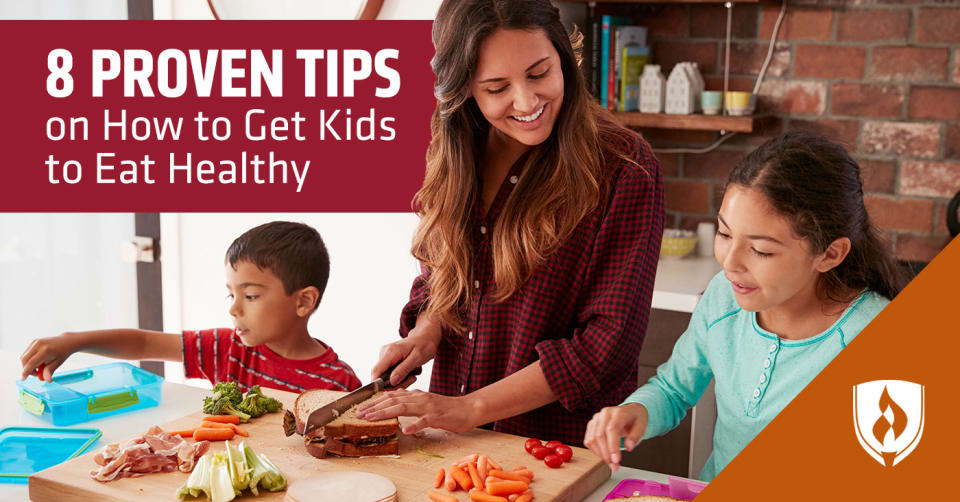It’s become your least favorite time of the day: dinnertime. The kids have turned up their nose at the salad and casserole you made. Now they’re negotiating for chicken nuggets and macaroni. You know that nutrition is important for your growing, energetic kiddos. But lately, you just don’t have it in you to fight these ongoing mealtime battles.

As you reluctantly put the salad away and tear open a bag of frozen nuggets, you wonder how to get kids to eat healthy. What can you do to make nutritious meals appealing to your kids?
Whether you’re a preschool teacher, a childcare provider or a frazzled parent, you need a few tricks up your sleeve for getting kids to eat healthy. We talked to experts in childcare and nutrition to uncover the answer to the question we’re all asking: “How do you get kids to eat healthy?”
8 Tips and strategies to get kids to eat healthier
Try these eight expert tricks to make mealtimes go a little smoother with your picky eaters. We can’t promise your two-year-old will never throw their carrot sticks on the floor again, but these ideas will help you take positive steps in the right direction.
1. Offer choices
No one likes to be forced to do something, especially rambunctious toddlers or older kids looking to establish their independence. This principle holds true at the kitchen table, too. Though the choice between apple slices and celery with peanut butter may not seem like much, it gives kids the autonomy they crave, while still keeping you in control of nutrition. Your little one might be more excited to try a new food or healthy dish if they feel as though it was their idea.
The little foodie in your kitchen might really enjoy meal planning as well. Lucy Harris, CEO at Hello Baby Bump, sits down and reviews the meal plan with her children every week. “Getting them involved allows them to have their say so they feel they’re being heard,” she says. Instead of running the risk of mac and cheese dinners for every meal, she gives her children guidelines for what each meal has to include. For example, at least three servings of veggies, one serving of carbohydrates and one serving of protein.
2. Let them make their own plates
Letting your children take control of their own plate is another way to let them exercise their independence and get them interested in trying new foods. It may take a few tries, but most kids will be more willing to add healthy foods to their plates, if they have the autonomy to choose.
Meals should generally include protein, a complex carbohydrate, vegetables, fruit and milk or another calcium-rich food, says Lisa Hugh, registered dietitian at Single Ingredient Groceries. By giving your child options within those categories, they’ll get to exercise choice while still getting nutritional components they need.
3. Introduce gateway foods
Children are naturally suspicious of new things, and that includes many healthy foods. So what’s the solution? Combine new foods with healthy options your child already likes. During a child’s first five years of life they’re learning what, when and how much to eat based on their families and cultural practices and attitudes, according to Aastha Kalra, physician and founder of Weight Zero MD.
While they’re forming their preferred tastes and habits, be sure to introduce them to a variety of food—fresh veggies and fruits, whole grains, proteins. This may keep them from becoming picky eaters later in in life, says Ysabel Montemayor, lead registered dietitian at Fresh n' Lean.
If they’re reluctant to try a new food, or they don’t like the taste much initially, try pairing it with something they enjoy. For example, if they are not a huge fan of carrot sticks, try pairing them with a dipping sauce they like. If they are adverse to broccoli, try putting it in omelets or mixing it into mac and cheese.
4. Snack smarter
Snacks are a fact of life for little ones and adults alike, but it’s important to keep these snacks in line. Remember to keep snack portion sizes for children small. Additionally, you’ll want to try to avoid ruining their appetite for dinner by providing snacks too close to dinner, says Jodi Greebel, registered dietitian at Citrition. If it’s close to dinnertime, you may want to consider giving them a taste of whatever veggies or other ingredients you’re cooking with.
It’s easy to hand over a baggie of cheesy crackers to an agitated child, but it’s not the best strategy for developing healthy eating habits. Snacks should be rich in protein and fiber since they’ll keep your child full for longer, says Montemayor. Giving your child healthy snack choices will keep snack time interesting while giving them exposure to new foods that you can integrate into dinner and lunch as well. Montemayor recommends the following snacks for little ones:
- Whole-grain crackers with cheese
- Apple slices with peanut butter
- Nuts
- Carrot or celery sticks with hummus
- Hard-boiled eggs
- Grapes
- Lightly salted/unsalted popcorn
5. Give kids a behind-the-scenes look at food
Kids are more likely to give healthy food a taste if they’re already interested and exposed to it. Children are naturally curious so giving them the opportunity to go to a farm or local farmer’s market will peak their interest in foods like vegetables, grains, fruit and dairy. Let them explore and find all the different shapes and colors vegetables and fruits grow in and pick which ones look best to them, says registered dietitian Emily Incledon.
For another activity, show them pictures or videos that explain how food works in the body. “Kids like to understand how things work,” says Greebel.
6. Include your kids while cooking
Kids are more likely to give a new food a try if they have had a hand in making it. Basic tasks like measuring ingredients, stirring a bowl or tossing a salad are all great starting points. As they perform these simple tasks, they’ll see how full dishes and entire meals come together, giving them a primer for preparing their own healthy meals as they get older. Cooking with preschoolers sometimes means cooking slower and simpler, but the payoff is worth it!
7. Don’t force it
As we mentioned earlier, choice is a key element to encouraging a healthy diet. Though exposing them to new foods and ways of preparing them can help raise adventurous eaters, it’s unlikely that they will love every food. In fact, despite your best efforts, you may have a picky eater on your hands.
“For those picky eaters keep trying,” says registered dietitian Marlisa Brown. Introduce foods more than once with different preparations as taste changes. Foods should always be offered in a variety of forms and with different seasonings. Never force or push picky eaters around you, just do what you can to encourage them.
8. Lead by example
Children are hugely influenced by their environment—this includes culture, media and family. Parental influence is especially important. Parents’ attitudes and habits around food can lead to healthy or disordered eating, says Dr. Kalra. The good news is there are several practices associated with developing healthy eaters:1
- Expose children to a variety of healthy and novel foods
- Praise them when they opt for healthy foods
- Make sure others around the child eat nutritiously as well, so they see it modeled for them.
Take the stress out of getting kids to eat healthy
Now that you have proven strategies on how to get kids to eat healthy, it’s time to put them to good use. With a little luck, you’ll be able to take the struggle out of mealtime and help the next generation develop lifetime healthy habits.
If you love seeing your kids try new foods and learn new skills, you may be cut out for life as a teacher. The natural nurturing skills you’ve developed as a parent provide an excellent foundation to build upon. Learn more about why in our article, “Teaching Toddlers: 10 Reasons Parents Make Great Teachers.”
1Hart, L. M., Damiano, S. R., Cornell, C., & Paxton, S. J. (2015). “What parents know and want to learn about healthy eating and body image in preschool children: a triangulated qualitative study with parents and early childhood professionals.” BMC Public Health. [accessed March, 2019] https://www.ncbi.nlm.nih.gov/pmc/articles/PMC4487845/
EDITOR’S NOTE: This article was originally published in 2015. It has since been updated to include information relevant to 2019.




